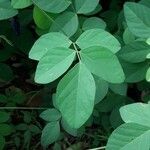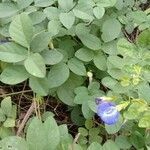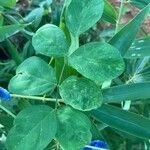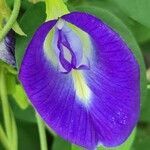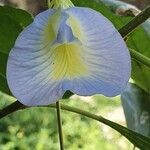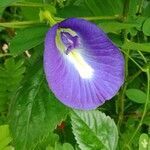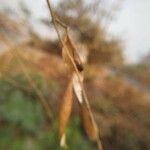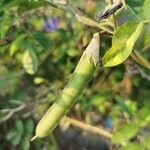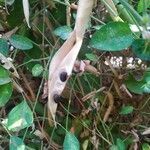Perennial climbing or trailing herb or suberect at base, 0·45–3 m. long; rootstock woody.. Stems slender, glabrescent or adpressed pubescent.. Leaflets 5–7, elliptic, oblong, oblong-lanceolate or almost round, 1–6·7 cm. long, 0·3–4 cm. wide, acute, rounded or emarginate at the apex, acute to rounded at the base, glabrescent above, adpressed pubescent beneath; petiole 1–3 cm. long; rhachis 1–6 cm. long; petiolules 1–3 mm. long; stipules persistent, lanceolate, 4–10 mm. long, veined.. Flowers axillary, solitary or paired; peduncle 0·3–1 cm. long; pedicels 6–9 mm. long; bracteoles ovate or round, 0·4–1·7 cm. long, 0·25–1·5 cm. wide, veined.. Calyx pubescent, veined; tube 8–12 mm. long; lobes oblong-lanceolate or triangular, 7–10 mm. long, 2·5–3 mm. wide, acute or acuminate, the upper pair joined for under one-third of their length.. Standard held lowermost, white or greenish-white, often margined with blue or entirely blue, basal central area often yellow or greenish, oblong-obovate, 2·5–5 cm. long, 1·5–3·5 cm. wide, extremely finely puberulous, margins sometimes ciliolate.. Pods linear-oblong, flattened, 6–12·5 cm. long, 0·7–1·2 cm. wide, margined, apiculate, glabrous or sparsely adpressed pubescent and minutely puberulous also.. Seeds 8–10, olive, pale brown or deep reddish-brown with dark mottling, or almost black, ellipsoid, oblong or oblong-reniform, sometimes truncate at one end, longest dimension 4·5–7 mm., shorter dimension 3–4 mm., 2–2·5 mm. thick, minutely punctulate on the faces.. Fig. 75.
Herbs. Stems twining, slender, densely deciduous adpressed shortly villous. Leaves 2.5-5 cm, pinnately 5-7-foliolate, usually 5-foliolate; stipules small, linear, 2-5 mm; petiole 1.5-3 cm; stipels small, bristlelike; petiolules 1-2 mm; leaflets broadly elliptic or almost ovate, 2.5-5 × 1.5-3.5 cm, thinly papery or almost membranous, adpressed shortly villous or sometimes glabrous on both surfaces, lateral veins 4 or 5 pairs, base obtuse, apex obtuse, slightly emarginate, usually with mucro. Flowers large, solitary in axil; bracteoles green, small, suborbicular or obovate, membranous, with obvious reticulate veins. Calyx membranous, 1.5-2 cm, 5-lobed; lobes lanceolate, less than 1/2 of tube, apex acuminate. Corolla sky blue, pink, or white, to 5.5 cm; standard faintly white or orange in middle, broadly obovate, ca. 3 cm, base shortly clawed; wings and keels much shorter than standard, both clawed; wings obovate-oblong; keels elliptic. Ovary villous. Legume brown, linear-oblong, 5-11 × 0.7-1 cm, compressed, with long beak. Seeds 6-10, black, oblong, ca. 0.6 × 0.4 cm, with obvious strophiole. Fl. and fr. Jun-Nov. 2n = (14, 15), 16.
A perennial herb plant. It grows to 3-4.5 m tall and spreads to 4 m wide. The stem is slender and twines. The leaves are green and divided. They are 6-12 cm long. The 5-9 leaflets are oval. The flowers are bright purple. They are pea like and 3-5 cm across. They have yellow tinted white centres. The flowers occur either singly or in pairs. The fruit are flat pods. They are 7 cm long. After the seeds fall the pods twist. The seeds are dark brown to black.
Per. twining herb climbing 5 m; lfts. 5-7, ovate, elliptic to obovate-elliptic, 1-5 cm long, 1-3 cm wide; infl. axillary, uniflwd., to 1.5 cm long; fls. pale to dark blue, 3.5-5.5 cm; br. subobscure calyx, 615 cm [?] diam.; calyx tube 8-14 mm long, lobes 7-12 mm long; fr. subsessile, flat, ecostate, 70-110 mm long, 8-11 mm wide.
Leaflets 2–3(4) pairs, membranous to chartaceous, 0.6–6.5 × 0.6–3.9 cm, ovate, elliptic, oblong or round, glabrescent above, pubescent beneath; petiole 1–3 cm long.
Flowers resupinate, 1–2 per axil, on a peduncle 3–10 mm long; pedicels 6–9 mm long; bracteoles 4–17 × 2–17 mm, ovate or round.
Standard white, often margined with blue or completely blue, 2.5–5 × 1.5–3.5(4) cm, shortly clawed, finely pubescent outside.
Pod 6–12.5 × 0.7–1.2 cm, linear-oblong, mucronate, compressed, glabrous or finely pubescent, 8–12-seeded.
Seeds light to dark brown or black, 5–7 × 3–4 × 2 mm, with a small white rim aril and funicular remnant.
Calyx 7–18 mm long, finely pubescent; lobes oblong, lanceolate or triangular.
Perennial herb, climbing trailing or suberect at the base; rootstock woody.
Flowers deep blue, occasionally pure white
A climber, somewhat shrubby below;
